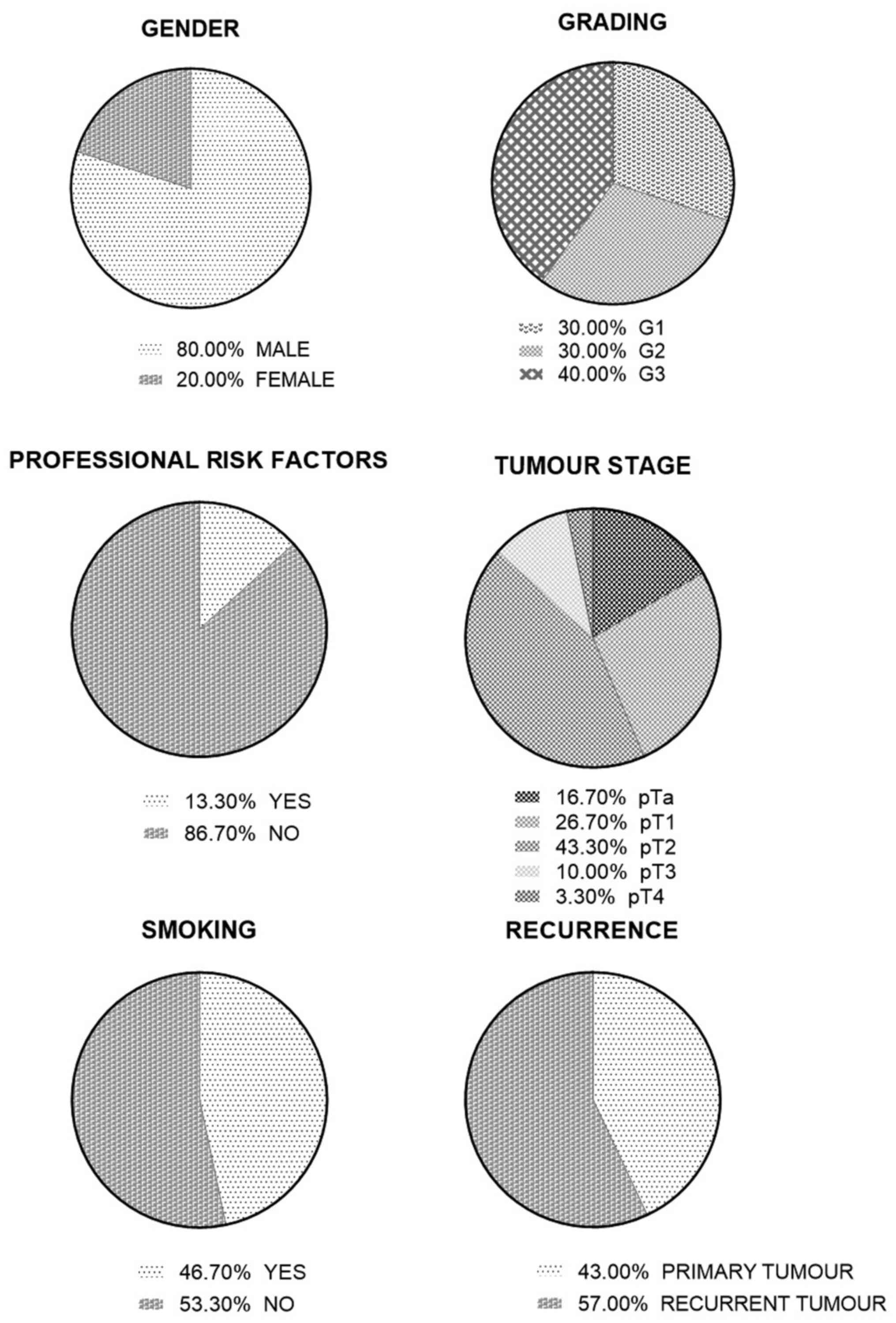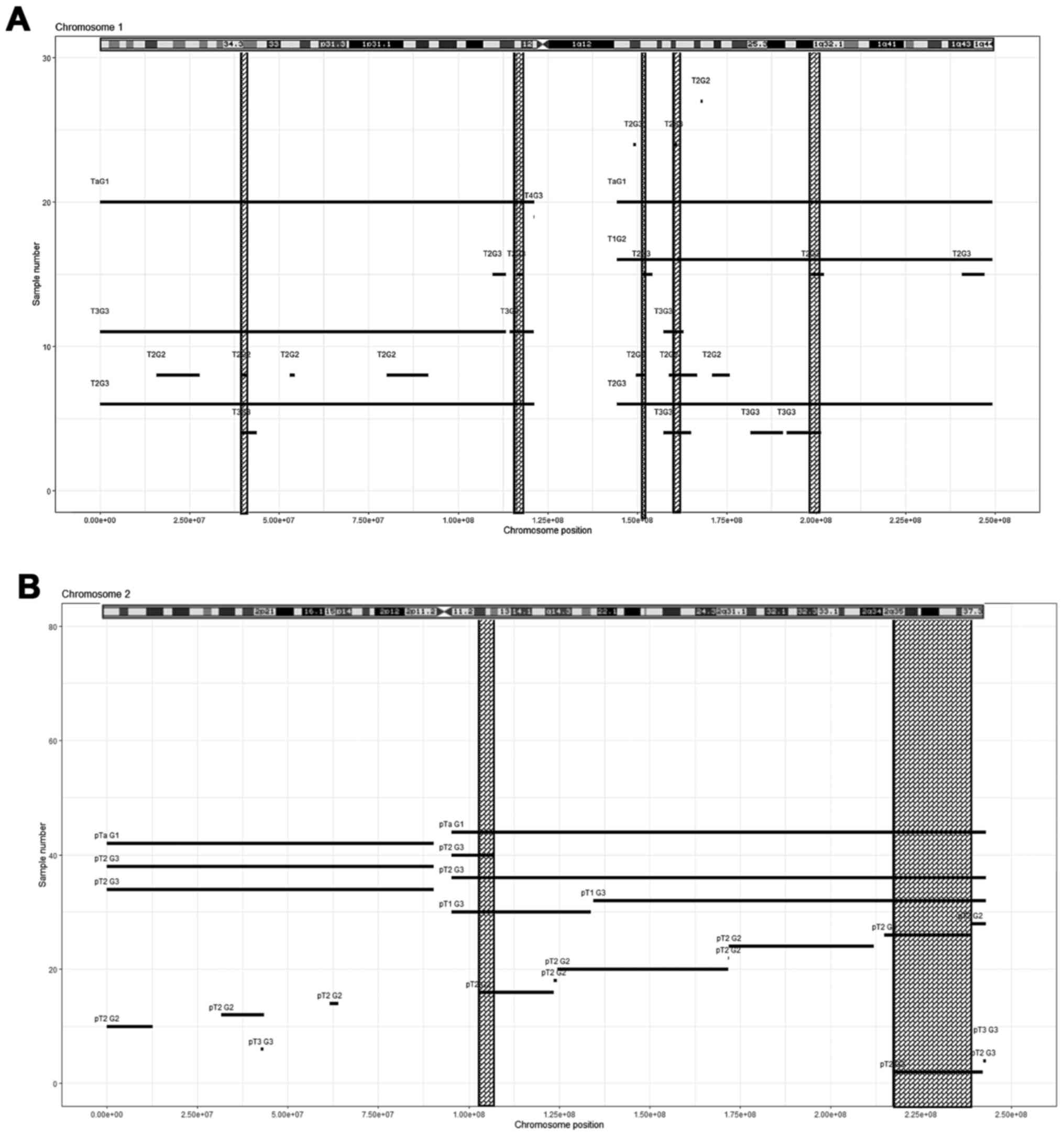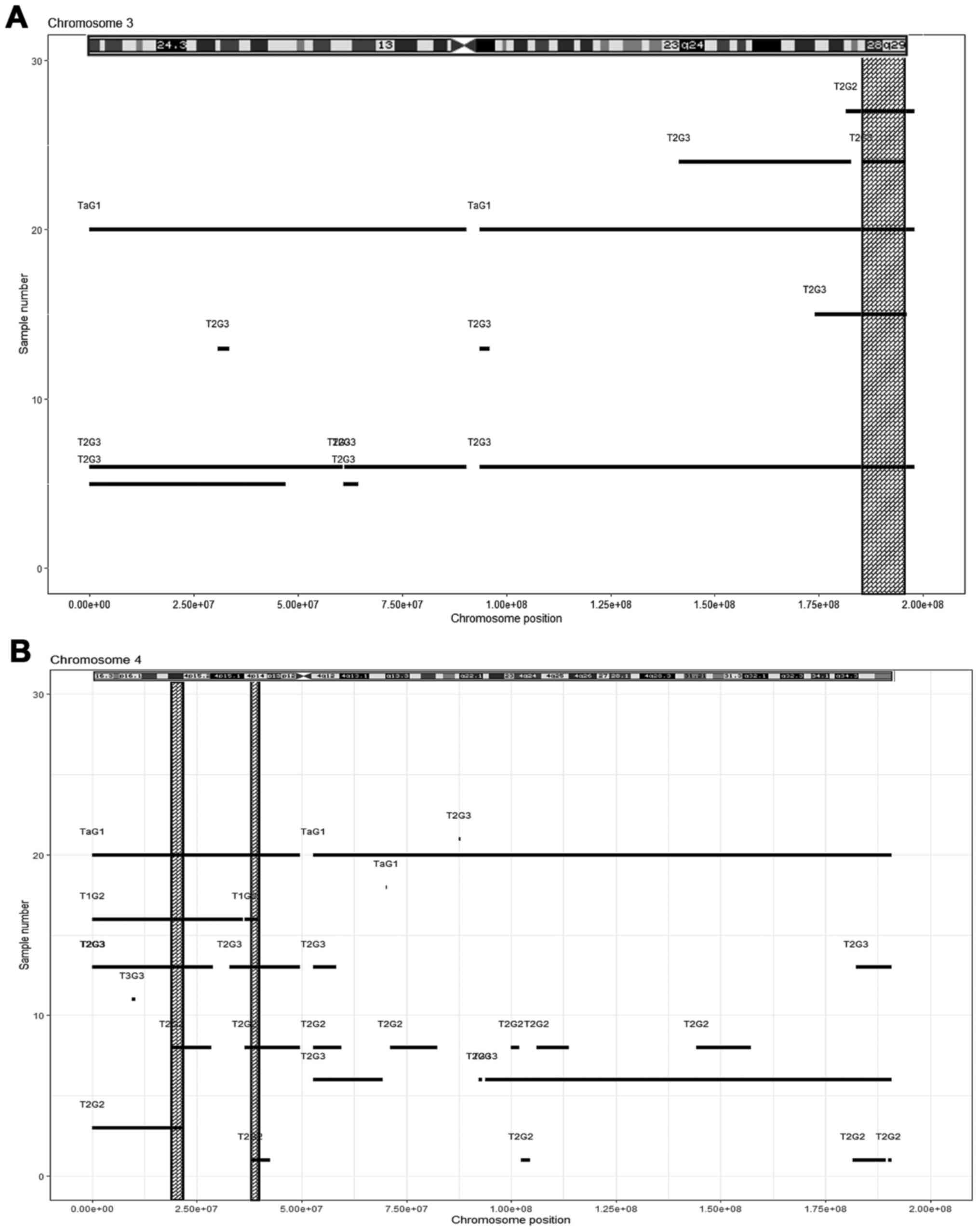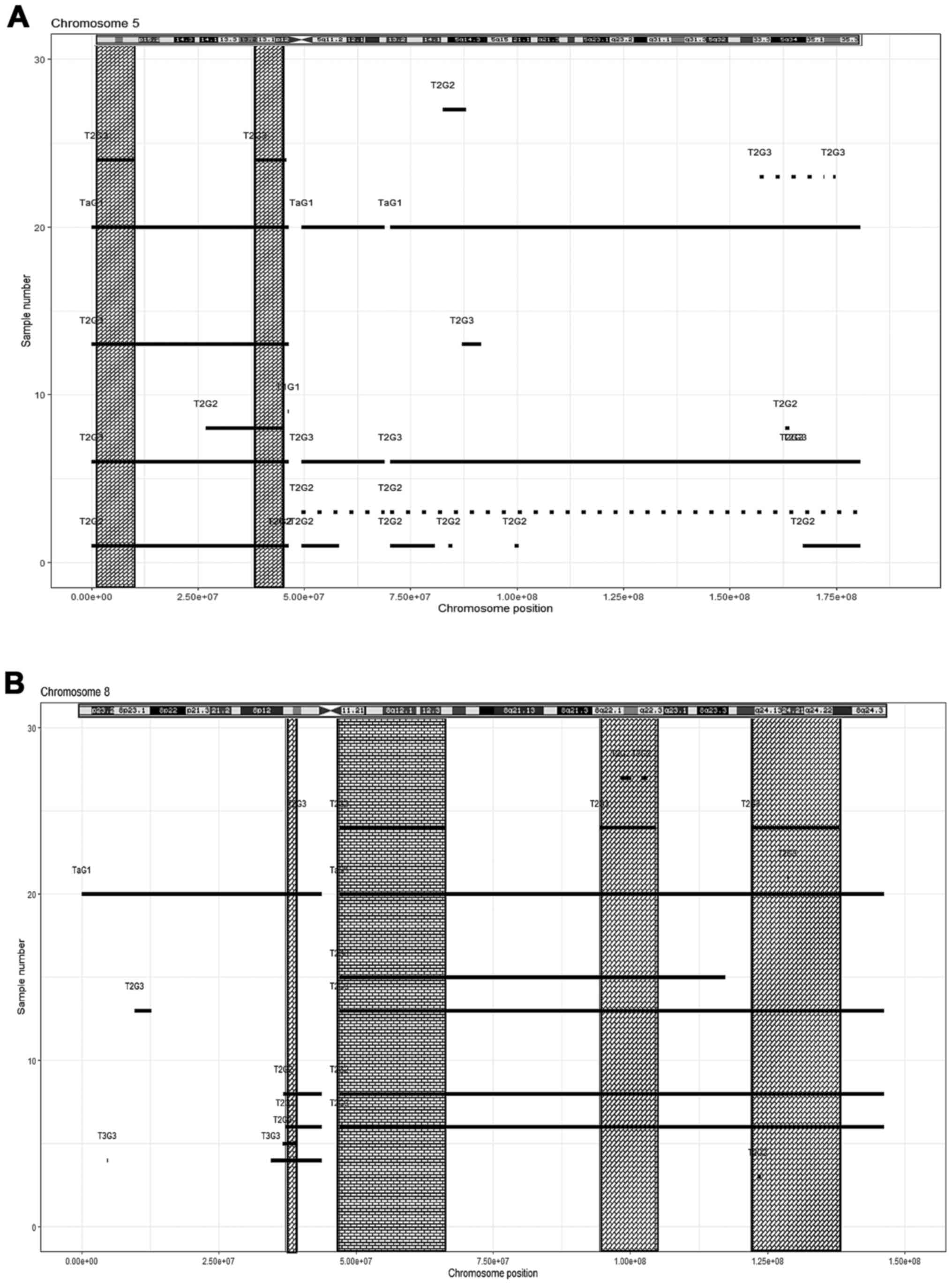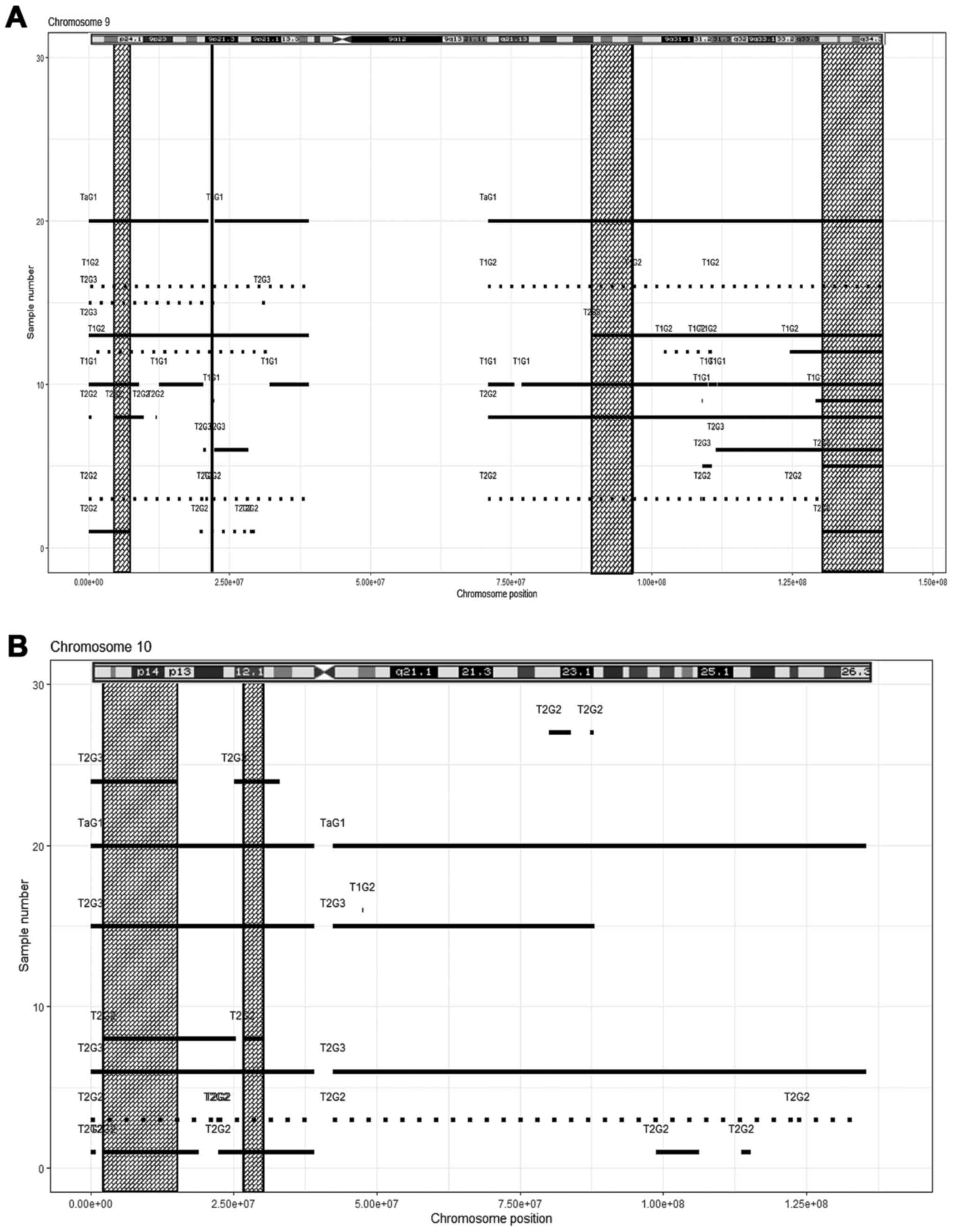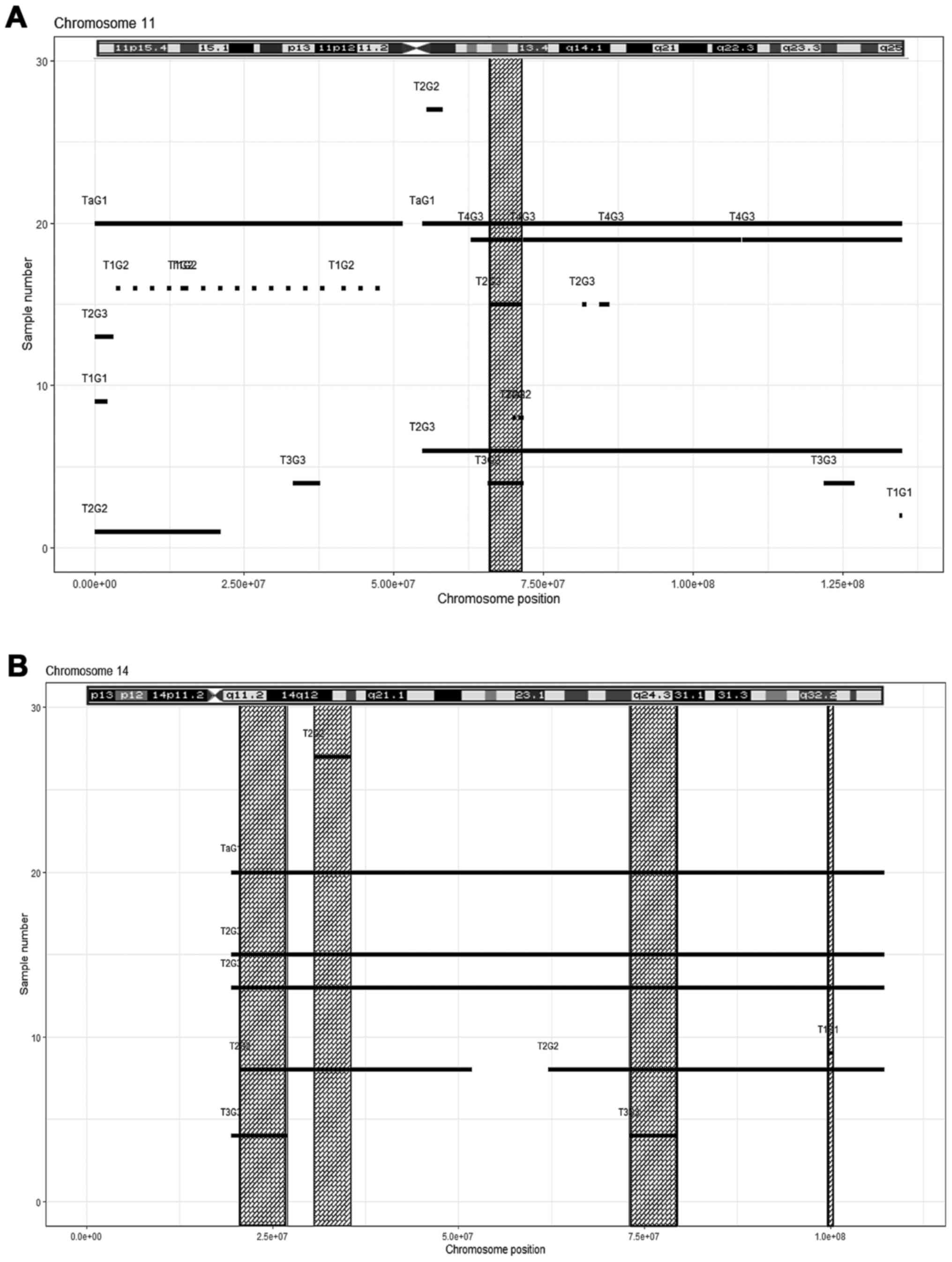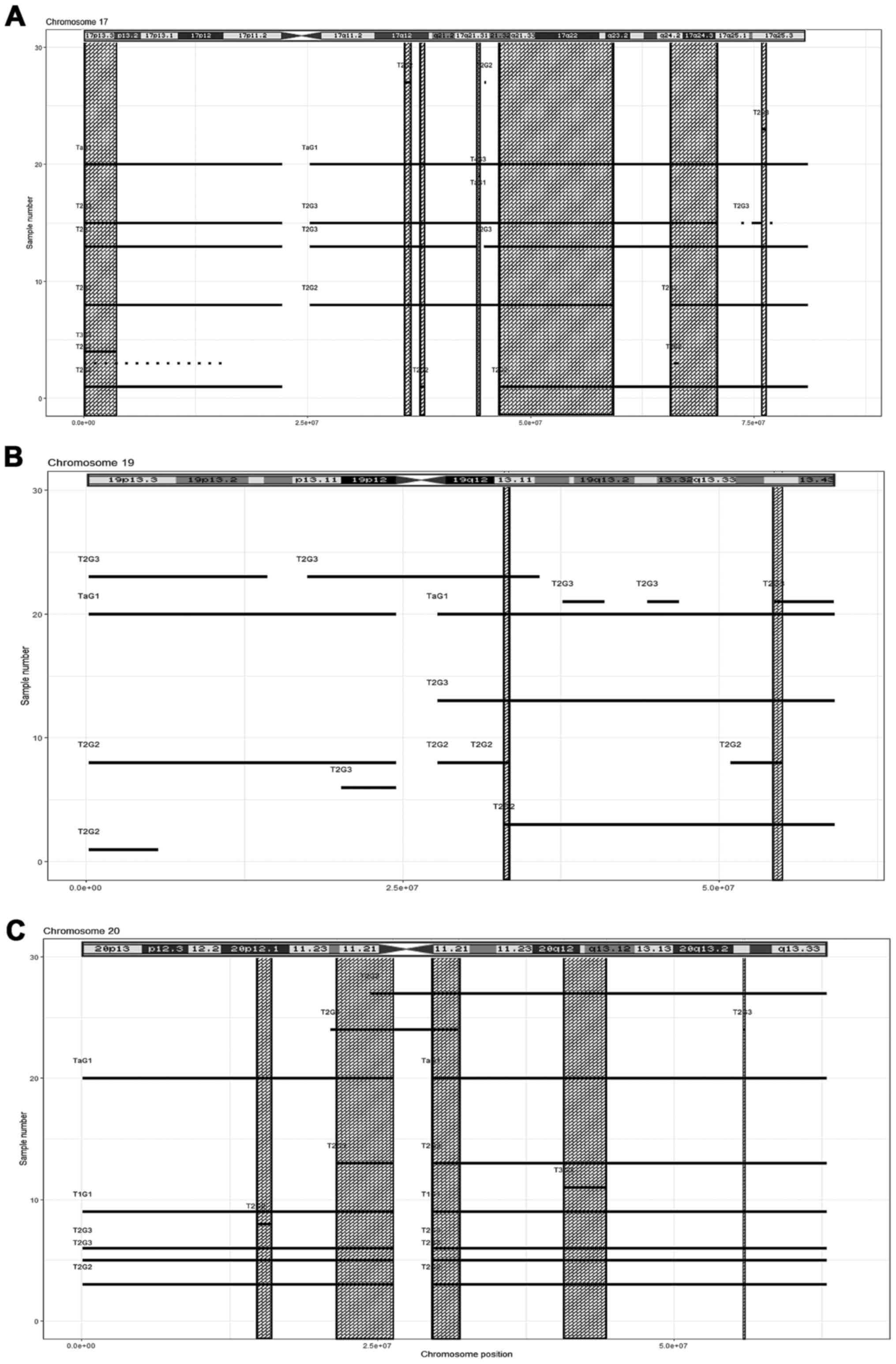Clinical impact of copy number variation changes in bladder cancer samples
- Authors:
- Published online on: June 24, 2021 https://doi.org/10.3892/etm.2021.10333
- Article Number: 901
-
Copyright: © Spasova et al. This is an open access article distributed under the terms of Creative Commons Attribution License.
Abstract
Introduction
The most successful approach to treating a disease has always been etiological therapy. In the case of bladder cancer, however, this approach remains inapplicable, as the mechanism of disease development has remained to be fully elucidated. Over 90% of bladder tumours are transitional cell carcinomas - frequently recurrent, but mostly non-invasive. However, they are a heterogeneous group with at least two distinct subgroups with different clinicopathological features-low-grade, non-infiltrating cancers and high-grade, muscle-invasive cancers (1). In addition, based on their clinical behavior, non-infiltrating tumours are subdivided into non-progressive (70%) and progressive types (10-20%), whereas high-grade, muscle-invasive cancers are subdivided into ones with a relatively good prognosis and those with a poor prognosis with a five-year survival rate of <50% (2). It is required to improve the current knowledge on this clinical diversity and the specific molecular mechanisms that underlie this variation in tumour behaviour.
Over 20% of non-invasive bladder tumours have been indicated to have genomic imbalances, including losses in the short (p) and long (q) chromosomal arm: 11p, 11q, 8p, 9, 17p, 3p and 12q and gains in the 8q21, 13q21-q34, 1q31, 3q24-q26 and 1p22 chromosomes (3). Deletions in the chromosomal regions 2q, 3p, 4p, 4q, 5q, 6q, 8p, 9p, 9q, 10q, 11p, 13q, 17p, 18q and Y and duplications/gains in 1q, 3q, 8q, 11q13, 17q and 20q and chromosome 7 are frequently detected (3-6).
In comparison, copy number variations are reported in 30% of invasive bladder tumours, including elevated copy number in the 1q23-24 chromosomal region, deletions in the 2q, 4q, 5p, 6q, 9p21.3, 8p23.1, 10p, 10q, 11p13 and 18q, as well as duplications in the 6p22, 8p12, 8q22, 11q13, 19q13 and 20q regions (7). In 2003, Veltman et al (8) reported significant correlations between copy number gain of CCNE1-containing regions and gain of ERBB2, as well as a correlation between copy number gain of CCND1 and deletion of TP53. So far, no interdependence has been established between CNV findings and tumour stage or grade.
Most of the studies related to quantitative genomic changes were performed with low-resolution comparative genomic hybridization (CGH). Studies on DNA imbalances in bladder cancer performed using high-resolution microarray-based CGH (aCGH) provided comprehensive information on quantitative genomic changes, but due to the small sample size (usually between 7 and 40 bladder cancer samples), they lacked statistical power (1,9-11). The situation with expression microarray studies, which focused on detecting changes in gene expression levels or mRNA levels, is similar (12-15). Despite the promising results from these studies, the current understanding of the mechanisms involved in the progression of bladder tumours remains insufficient. Advances in molecular methods allowing for high-resolution locus-by-locus detection of CNVs may possibly improve the understanding of the molecular pathology of bladder cancer progression and facilitate the discovery of novel drug targets and therapeutic approaches (16).
The aim of the present pilot study was to detect CNVs related to tumour progression and metastasis of urothelial carcinoma through whole-genome CNV scans of fresh frozen samples.
Materials and methods
Ethics
This study was approved by the Ethical Committee of the Medical University of Sofia (Sofia, Bulgaria; protocol No. 04/09/03/2018). Written informed consent and a questionnaire on family history, as well as professional and environmental health hazards, were obtained from all participants prior to tissue collection.
Bladder cancer samples
A total of 30 bladder cancer samples from 6 females and 24 males were collected for the present study. Samples were collected for 12 months (January 2018 to January 2019) at the Department of Urology, UMBALSM N.I. Pirogov and Department of Urology, Tsaritsa Yoanna University Hospital. The clinical and pathological characteristics of the studied cohort are described according to the age of the patients, sex, smoking habits, professional risk factors, tumor stage and grade (Table I).
Table ISummary of the clinical and pathological characteristics of patients with bladder cancer used in the present study. |
aCGH
The samples were transported in sterile containers at 4˚C to the genetic laboratory, where DNA was extracted using a standard phenol-chloroform extraction protocol and stored at -20˚C. Isolated DNA was quantitatively assessed spectrophotometrically (NanoDrop® ND-2000c; Thermo Fisher Scientific, Inc.) and qualitatively by horizontal low-voltage agarose gel electrophoresis (Horizon 20-25; GibcoBRL; Thermo Fisher Scientific, Inc.).
Two independent platforms were used for the detection of genomic imbalances: i) CytoChip ISCA 4x44K v1.0 (BlueGnome), scanned with an Agilent G2505 microarray scanner (Agilent Technologies, Inc.) and analysed by BlueFuse Multi v3.1 (Illumina, Inc.) and ii) Infinium OncoArray-500K BeadChip (Illumina, Inc.), scanned with iScan (Illumina, Inc.) and analysed using KaryoStudio v.1.4 (Illumina, Inc.).
A total of 20 bladder cancer samples were analysed with the OncoArray-500K BeadChip, 12 cancer samples were analysed with the CytoChip ISCA 4x44K v1.0 and two tumour samples were analysed using both methods to confirm the robustness of the results.
All procedures, including sample preparation, sample processing, hybridization, scanning and data analysis, were performed using the manufacturers' standard protocols.
Genotype/phenotype interrelation
The interconnection between the genomic alterations and the clinical phenotype of tumours was assessed by a detailed analysis of publicly available databases such as the Database of Genomic Variants (DGV; http://projects.tcag.ca/variation/) and the Catalogue of Somatic Mutations in Cancer (Cosmic; https://cancer.sanger.ac.uk/cosmic).
Results
Bladder cancer samples
The clinical and pathological characteristics of the cohort are described in Table I and Fig. 1. The individual data for each case are presented in Table SI. The mean age of the studied patients was 67.77±9.3 years. A total of 46.7% of patients were smokers, with an average cigarette consumption of 16.9±6.19 per day. Four patients (13.3%) had professional risk factors related to the transport, oil and chemical industries.
CNV analysis
A total of two of the studied samples exhibited copy number changes in >70% of the genome. Therefore, they did not meet the qualitative criteria of the platform used and were excluded from any further analysis. Data from the remaining 28 samples were included in the next analytical steps. A total of 524 aberrations, including 175 losses and 349 gains, were detected (Table II).
According to the tumour stage, the aberrations were distributed as follows: Ta, n=64 (12.2%); T1, n=64 (12.2%); T2, n=334 (63.7%); T3, n=49 (9.4); and T4, n=13 (2.5%). The mean number of aberrations per tumour was as follows: Ta, 16 (range, 0-44); T1, 9 (range, 0-19); T2, 25.7 (range, 0-70); T3, 16.3 (range, 13-24); and T4, 13 (only one sample). Additionally, the number of aberrations were the highest for T2-stage tumours and the lowest for T1-stage tumours (Tables II and SII)
Detected aberrations were distributed according to tumour grade as follows: 19.7% (n=103) in G1 tumours, 37% (n=194) in G2 and 43.3% (n= 227) in G3 tumours. The total number of aberrations in G3 tumours was more than twice as high as that in tumours of the lowest grade G1, but the average number of aberrations per tumour was similar in the different tumour classes, with 14.7 aberrations in G1 (range, 1-45), 21.5 in G2 (range, 0-91) and 18.9 in G3 (range, 0-37) (Tables II and SII).
Only 10.7% (n=3) of the 28 cancer samples carried no chromosomal aberrations. The remaining 89.3% (n=25) displayed multiple chromosomal copy number changes. Of all imbalances, 396 (75.6%) were located in autosomal chromosomes. Autosomal chromosomal regions were classified based on the number of detected imbalances as follows: i) Group 1 (0-5 CNVs detected), representing 7 chromosomal regions that harboured 6.3% (n=25) of all genomic imbalances, with 21q (n=1), 12p (n=2), 12q (n=4), 16p (n=4), 16q (n=4), 11p (n=5) and 18p (n=5); ii) Group 2 (6-9 CNVs detected), representing 14 chromosomal regions that harbour 27% (n=107) of all genomic imbalances, with 2p (n=8), 3p (n=7), 3q (n=7), 7p (n=7), 8p (n=8), 14q (n=9), 15q (n=6), 17p (n=7), 18q (n=8), 19p (n=6), 19q (n=9), 20p (n=8), 20q (n=9) and 22q (n=8); iii) Group 3 (≥10 CNVs detected), representing the remaining 18 autosomal chromosomal regions harbouring 66.7% (n=264) of all genomic imbalances, with 1p (n=12), 1q (n=16), 2q (n=15), 4p (n=11), 4q (n=16), 5p (n=10), 5q (n=18), 6p (n=23), 6q (n=13), 7q (n=10), 8q (n=12), 9p (n=25), 9q (n=23), 10p (n=13), 10q (n=10), 11q (n=13), 13q (n=10) and 17q (n=14) (Table SII). Chromosome 9 was the most severely affected, displaying 25 CNVs in the short arm and 23 in the long chromosomal arm, which accounted for 12.1% of all autosomal aberrations.
The share of sex chromosomal imbalances stood at 24.4% (n=128). The highest frequency of CNVs per chromosome was detected in the sex chromosomes, with 49 in the X (both losses and gains) and 79 in the Y chromosome (only losses - partial or complete) (Table SII).
Among the autosomal chromosomal regions with a high number of CNVs (≥10) (n=264), 79.9% of variations (n=211) were chromosomal gains, while 20.1% (n=53) were losses. Five copy-neutral aberrations (LOH variants) were detected (Table III). Furthermore, 19.7% (n=52) of the copy number changes were <800 kB, frequently reported in DGV as polymorphic findings, so they were classified as ‘benign’. Of the remaining CNVs, 76.1% (n=201) were labelled as pathogenic and 4.2% (n=11) were classified as variants with uncertain significance. According to the tumour stage, the aberrations were distributed in the following way: Ta, n=25; T1, n=30; T2, n=191; T3, n=1; and T4, n=6. According to the tumour grade, the majority of aberrations were present in G2-grade tumours and were distributed as follows: G1, n=40 (15.15%); G2, n=122 (46.21%); and G3, n=102 (38.64%) (Table SII).
Among the pathogenic gains, 16.04 (n=45) had overlapping regions in at least four different tumour samples, mostly high-grade: Chromosome 1, five regions (Fig. 2A, Table IV); chromosome 2, two regions (Fig. 2B, Table IV); chromosome 3, one region (Fig. 3A, Table IV); chromosome 4, two regions (Fig. 3B, Table IV); chromosome 5, two regions (Fig. 4A, Table IV); chromosome 8, four regions (Fig. 4B, Table IV). In chromosome 9, four overlapping chromosomal regions were detected, with both gains and losses (Fig. 5A, Table IV). Furthermore, the following overlapping regions were detected: Chromosome 10, two regions (Fig. 5B, Table IV); chromosome 11, one region (Fig. 6A, Table IV); chromosome 14, four regions (Fig. 6B, Table IV); chromosome 17, seven regions (Fig. 7A, Table IV); chromosome 19, two regions (Fig. 7B, Table IV); and chromosome 20, five regions (Fig. 7C, Table IV). The results obtained from the follow-up analysis of genes from the pathogenic gain regions are presented in Table V. This table includes genes related to cancer treatment, resistance, initiation, cell-cycle deregulation, tumor progression and metastases.
Comparison between the two CNV detection platforms
The two samples analysed with both platforms demonstrated no difference in the detected chromosomal abnormalities. Due to the higher resolution of the Infinium OncoArray-500K BeadChip (Illumina, Inc.), the coordinates of the detected aberrations were mapped comparatively more precisely. The region arr16q23.1q24 (74356681-88675439)x1, designated as one region by CytoChip ISCA 4x44K v1.0, was recognized as two regions, namely arr16q23.1(74500123-75740477)x1 and arr16q23.1 (75766088-77151891)x0, by the Infinium OncoArray-500K BeadChip. The latter platform detected an additional chromosomal region, arr16p12.1p11 (24577766-35173765)x3, which was below the resolution of the CytoChip ISCA 4x44K v1.0 arrays. Only the design of the Infinium OncoArray-500K BeadChip allowed for the detection of LOH regions.
LOH variants
Among the 19 tumour samples analysed with the Infinium OncoArray-500K BeadChip, five LOH variants were detected in chromosomes 6, 7, 11 and 17 Table V. These variants contained 176 genes (Table SIII).
Discussion
In the present study, a CNV analysis of 30 bladder cancer samples was performed. Despite the small number of patients in the present cohort, the epidemiological data obtained demonstrated the role of external hazardous factors in the development of bladder cancer. More than 46% of patients demonstrated unhealthy smoking habits and 13.3% had professional risk factors. These findings are consistent with results of previously conducted larger studies (17).
The high number of detected CNVs testifies the high level of genomic instability observed in both high-grade tumours (G3) and low-grade tumours (G1), and is in concordance with results of previous studies (1). The results obtained with regard to the role of Y-chromosome imbalances in bladder cancer were consistent with the insight gained in a study that demonstrated a strong tendency of Y-chromosome loss (18), but were partially in contrast to the studies of Conconi et al (1) from 2014 and Panani and Roussos (19) from 2006, where Y-chromosome amplification was detected. Due to the small size of the Y chromosome, the phenomenon of age-related loss of the Y chromosome and the development of bladder cancer in adulthood (20), it may be assumed that the loss of the Y chromosome in bladder cancer is a non-specific phenomenon.
A high number of genes related to cancer treatment, resistance, initiation and cell-cycle deregulation were located in the regions with pathogenic gains. Genes related to invasion and metastasis, in line with the aims of the present study, were the focus of the consequent data analysis. These genes are discussed below.
In tree CNV regions in chromosome 9, both losses and gains were detected: arr9p24.2p24.1 (4483189-7324382)x1, arr9p24.2p24.1 (4483189-7324382)x3 arr9p21.3 (21746274-22004153)x1, arr9p21.3 (21746274-22004153)x3, arr9q21.33q22.32 (89345014-96677307)x1 and arr9q21.33q22.32 (89345014-96677307)x3. These could be unspecific events due to high level of genomic instability in those regions. In the fourth region of chromosome 9, arr9q33.3q34.3(130265117-141098428), nine gains and only one loss were observed; thus, the further analysis so only focused on gain variants. The genes that may be related to invasion and metastasis in this region were SH2D3C, ENG, CDK9, LRRC8A, VAV2, PPP1R26, EGFL7, EXD3, NRARP, RABL6, PTGDS, DDX31, SNHG7 and CACNA1B.
Among the regions with a gain in chromosome 17, arr17q21.31(44161441-44351452)x3, a systemic gain in DGV was commonly present and thus, it may be classified as a likely benign variant. Among the other gained regions, the genes that may be related to tumour progression and metastasis were RTN4RL1, DOC2B, TBC1D3, MIEN1, GRB7, HOXB7, SPOP, DLX4, MIR454, ANKRD40CL, SPAG9, AKAP1, TRIM37, KPNA2, MAP2K6, SOX9 and TNRC6C-AS1.
In the gained region of chromosome 19, only LILRB2 and CNOT3 genes in arr19q13.42(54332068-54919859)x3 were indicated to be potentially related to cancer progression.
Certain genes detected in the regions with gains discussed above have already been reported to be involved in bladder cancer genesis and progression. These genes included the following: PFDN2 located on 1q23.3, detected in the urinary DNA with aCGH technique (21); COL6A3 located in 2q37.3, which promotes epithelial-mesenchymal transition in bladder cancer cells via the TGF-β/Smad pathway (22); DNER in 2q36.3, involved in proliferation, migration and invasion by regulating the activation of the PI3K/AKT pathway (23). OSMR in 5p13.1 was indicated to be closely associated with cell growth and differentiation, inflammation and enhancement of metastatic capacity in urinary bladder cancer (24). MYC, located in 8q24.21, has been reported in numerous studies to be involved in cell growth and migration in bladder cancer (25). Genes DDX31 and SNHG7, which are oncogenes that have been reported to be dysregulated in various tumour types, have also been previously indicated to be involved in bladder cancer metastases (26,27). Both are located in the ‘gain’ chromosomal region in the terminal end of chromosome 9, arr9q33.3q34.3(130265117-141098428). The SLC39A11 located in 17q24.3-q25.1 has been reported to be associated with survival of patients with bladder cancer (28). The enhanced methylation status of PRAC1 in 17q21.32 has been linked to a high recurrence rate and progression in patients with bladder cancer (29). Chen et al (30) indicated that the KAT7 in 17q21.33, promotes cell proliferation in bladder cancer samples.
The genes detected in the LOH regions may be investigated in further studies and functional analyses regarding their potential tumour-suppressor role may be performed.
One limitation of the present study is the small sample size. However, even in this small cohort, a large quantity of aberrations were detected, which are difficult to classify without any strict statistical, histological and bioinformatical criteria, which unfortunately have not yet been developed. Additionally, a relatively small sample cohort may lead to statistical errors with overrepresentation of certain aberrations and therefore, the prevalence rate of particular chromosomal aberrations may not be representative of bladder cancer imbalances in general. Another limitation of the study is that the analysis of genomic imbalances was performed at the DNA level only, so the next step should be gene expression analysis or functional investigation of identified genes that have not already been reported elsewhere to be involved in bladder cancer. Despite the limitations of the present study, the results obtained are of significant scientific value, as they provide certain mechanisms that may be responsible for tumour invasion caused by genetic imbalances related to the activation of genes with metastatic and proliferative potential. A total of 42 recurrent CNVs, mostly in high-grade bladder tumours, were detected in chromosomes 1-5, 8-11, 14, 17, 19 and 20. Furthermore, in the present study, genes potentially related to the metastatic potential of uroepithelial tumours were identified that may be further studied as possible targets for precision therapy. Finally, five LOH variants in high-grade bladder cancer tumours were described.
In conclusion, the present study demonstrated that applying genomic approaches to bladder cancer research is crucial for furthering the current knowledge on the progression of the disease and the inclusion of these technologies as part of routine patient care, thus accelerating the implementation of a personalized therapeutic approach.
Supplementary Material
Clinical and pathological characteristics of patients with bladder cancer.
Number of detected CNVs distributed by chromosomal arm (p and q), tumour stage and grade.
Genes located in the detected LOH regions.
Acknowledgements
Bulgarian Ministry of Education and Science under the National Program for Research ‘Young Scientists and Postdocotral Students’.
Funding
Funding: This work was funded by the Bulgarian Ministry of Education (grant no. DM13/4, 2017) and the Medical University of Sofia (grant no. D-60/03.05.2018).
Availability of data and materials
The datasets used and/or analysed during the current study are available from the corresponding author on reasonable request.
Authors' contributions
OA was involved in the conception of the study, sample processing and writing of the manuscript. BM, SR and CS were involved in tumour sample collection. ZH and DN were involved in DNA isolation. LB, RV and SH were involved in CNV detection. VS and MG analysed the data and prepared the figures. DS and RS were involved in statistical analyses. DT was involved in study design and manuscript revision. OA, LB and RV confirm the authenticity of all the raw data. All the authors read and approved the final version of the manuscript.
Ethics approval and consent to participate
This study was approved by the Ethical Committee of the Medical University of Sofia (Sofia, Bulgaria; protocol no. 04/09/03/2018). Written informed consent was obtained from the participants prior to tissue collection.
Patient consent for publication
Not applicable.
Competing interests
The authors declare that they have no competing interests.
References
|
Conconi D, Panzeri E, Redaelli S, Bovo G, Viganò P, Strada G, Dalprà L and Bentivegna A: Chromosomal imbalances in human bladder urothelial carcinoma: Similarities and differences between biopsy samples and cancer stem-like cells. BMC Cancer. 14(646)2014.PubMed/NCBI View Article : Google Scholar | |
|
Kawanishi H, Takahashi T, Ito M, Matsui Y, Watanabe J, Ito N, Kamoto T, Kadowaki T, Tsujimoto G, Imoto I, et al: Genetic analysis of multifocal superficial urothelial cancers by array-based comparative genomic hybridisation. Br J Cancer. 97:260–266. 2007.PubMed/NCBI View Article : Google Scholar | |
|
Kallioniemi A, Kallioniemi OP, Citro G, Sauter G, DeVries S, Kerschmann R, Caroll P and Waldman F: Identification of gains and losses of DNA sequences in primary bladder cancer by comparative genomic hybridization. Genes Chromosomes Cancer. 12:213–219. 1995.PubMed/NCBI View Article : Google Scholar | |
|
Sauter G: Rudolf Virchow Prize 1997. Molecular cytogenetic analysis of superficial urothelial cancer of the bladder. Verh Dtsch Ges Pathol. 81:18–27. 1997.PubMed/NCBI(In German). | |
|
Voorter C, Joos S, Bringuier PP, Vallinga M, Poddighe P, Schalken J, du Manoir S, Ramaekers F, Lichter P and Hopman A: Detection of chromosomal imbalances in transitional cell carcinoma of the bladder by comparative genomic hybridization. Am J Pathol. 146:1341–1354. 1995.PubMed/NCBI | |
|
Zaharieva BM, Simon R, Diener PA, Ackermann D, Maurer R, Alund G, Knönagel H, Rist M, Wilber K, Hering F, et al: High-throughput tissue microarray analysis of 11q13 gene amplification (CCND1, FGF3, FGF4, EMS1) in urinary bladder cancer. J Pathol. 201:603–608. 2003.PubMed/NCBI View Article : Google Scholar | |
|
Huang WC, Taylor S, Nguyen TB, Tomaszewski JE, Libertino JA, Malkowicz SB and McGarvey TW: KIAA1096, a gene on chromosome 1q, is amplified and overexpressed in bladder cancer. DNA Cell Biol. 21:707–715. 2002.PubMed/NCBI View Article : Google Scholar | |
|
Veltman JA, Fridlyand J, Pejavar S, Olshen AB, Korkola JE, DeVries S, Carroll P, Kuo WL, Pinkel D, Albertson D, et al: Array-based comparative genomic hybridization for genome-wide screening of DNA copy number in bladder tumors. Cancer Res. 63:2872–2880. 2003.PubMed/NCBI | |
|
Bellmunt J, Selvarajah S, Rodig S, Salido M, de Muga S, Costa I, Bellosillo B, Werner L, Mullane S, Fay AP, et al: Identification of ALK gene alterations in urothelial carcinoma. PLoS One. 9(e103325)2014.PubMed/NCBI View Article : Google Scholar | |
|
Scaravilli M, Asero P, Tammela TL, Visakorpi T and Saramäki OR: Mapping of the chromosomal amplification 1p21-22 in bladder cancer. BMC Res Notes. 7(547)2014.PubMed/NCBI View Article : Google Scholar | |
|
Weilandt M, Koch A, Rieder H, Deenen R, Schwender H, Niegisch G and Schulz WA: Target genes of recurrent chromosomal amplification and deletion in urothelial carcinoma. Cancer Genomics Proteomics. 11:141–153. 2014.PubMed/NCBI | |
|
Ewald JA, Downs TM, Cetnar JP and Ricke WA: Expression microarray meta-analysis identifies genes associated with Ras/MAPK and related pathways in progression of muscle-invasive bladder transition cell carcinoma. PLoS One. 8(e55414)2013.PubMed/NCBI View Article : Google Scholar | |
|
Hussain SA, Palmer DH, Syn WK, Sacco JJ, Greensmith RM, Elmetwali T, Aachi V, Lloyd BH, Jithesh PV, Arrand J, et al: Gene expression profiling in bladder cancer identifies potential therapeutic targets. Int J Oncol. 50:1147–1159. 2017.PubMed/NCBI View Article : Google Scholar | |
|
Mengual L, Burset M, Ars E, Lozano JJ, Villavicencio H, Ribal MJ and Alcaraz A: DNA microarray expression profiling of bladder cancer allows identification of noninvasive diagnostic markers. J Urol. 182:741–748. 2009.PubMed/NCBI View Article : Google Scholar | |
|
Sanchez-Carbayo M: Use of high-throughput DNA microarrays to identify biomarkers for bladder cancer. Clin Chem. 49:23–31. 2003.PubMed/NCBI View Article : Google Scholar | |
|
de Ravel TJ, Devriendt K, Fryns JP and Vermeesch JR: What's new in karyotyping? The move towards array comparative genomic hybridisation (CGH). Eur J Pediatr. 166:637–643. 2007.PubMed/NCBI View Article : Google Scholar | |
|
Letasiova S, Medve'ova A, Sovcikova A, Dušinská M, Volkovová K, Mosoiu C and Bartonová A: Bladder cancer, a review of the environmental risk factors. Environ Health. 11 Suppl 1(Suppl 1)(S11)2012.PubMed/NCBI View Article : Google Scholar | |
|
Minner S, Kilgue A, Stahl P, Weikert S, Rink M, Dahlem R, Fisch M, Höppner W, Wagner W, Bokemeyer C, et al: Y chromosome loss is a frequent early event in urothelial bladder cancer. Pathology. 42:356–359. 2010.PubMed/NCBI View Article : Google Scholar | |
|
Panani AD and Roussos C: Sex chromosome abnormalities in bladder cancer: Y polysomies are linked to PT1-grade III transitional cell carcinoma. Anticancer Res. 26(1A):319–323. 2006.PubMed/NCBI | |
|
Forsberg LA: Loss of chromosome Y (LOY) in blood cells is associated with increased risk for disease and mortality in aging men. Hum Genet. 136:657–663. 2017.PubMed/NCBI View Article : Google Scholar | |
|
Lopez V, Gonzalez-Peramato P, Suela J, Serrano A, Algaba F, Cigudosa JC, Vidal A, Bellmunt J, Heredero O and Sánchez-Carbayo M: Identification of prefoldin amplification (1q23.3-q24.1) in bladder cancer using comparative genomic hybridization (CGH) arrays of urinary DNA. J Transl Med. 11(182)2013.PubMed/NCBI View Article : Google Scholar | |
|
Huang Y, Li G, Wang K, Mu Z, Xie Q, Qu H, Lv H and Hu B: Collagen Type VI Alpha 3 Chain promotes epithelial-mesenchymal transition in bladder cancer cells via transforming growth factor β (TGF-β)/Smad pathway. Med Sci Monit. 24:5346–5354. 2018.PubMed/NCBI View Article : Google Scholar | |
|
Liang Y, Luo H, Zhang H, Dong Y and Bao Y: Oncogene Delta/Notch-Like EGF-Related receptor promotes cell proliferation, invasion, and migration in hepatocellular carcinoma and predicts a poor prognosis. Cancer Biother Radiopharm. 33:380–386. 2018.PubMed/NCBI View Article : Google Scholar | |
|
Deng S, He SY, Zhao P and Zhang P: The role of oncostatin M receptor gene polymorphisms in bladder cancer. World J Surg Oncol. 17(30)2019.PubMed/NCBI View Article : Google Scholar | |
|
Sun J, Zhang H, Tao D, Xie F, Liu F, Gu C, Wang M, Wang L, Jiang G, Wang Z and Xiao X: CircCDYL inhibits the expression of C-MYC to suppress cell growth and migration in bladder cancer. Artif Cells Nanomed Biotechnol. 47:1349–1356. 2019.PubMed/NCBI View Article : Google Scholar | |
|
Chen Y, Peng Y, Xu Z, Ge B, Xiang X, Zhang T, Gao L, Shi H, Wang C and Huang J: Knockdown of lncRNA SNHG7 inhibited cell proliferation and migration in bladder cancer through activating Wnt/β-catenin pathway. Pathol Res Pract. 215:302–307. 2019.PubMed/NCBI View Article : Google Scholar | |
|
Daizumoto K, Yoshimaru T, Matsushita Y, Fukawa T, Uehara H, Ono M, Komatsu M, Kanayama HO and Katagiri T: A DDX31/Mutant-p53/EGFR Axis promotes multistep progression of Muscle-Invasive bladder cancer. Cancer Res. 78:2233–2247. 2018.PubMed/NCBI View Article : Google Scholar | |
|
Wu L, Chaffee KG, Parker AS, Sicotte H and Petersen GM: Zinc transporter genes and urological cancers: Integrated analysis suggests a role for ZIP11 in bladder cancer. Tumour Biol. 36:7431–7437. 2015.PubMed/NCBI View Article : Google Scholar | |
|
Kim YW, Yoon HY, Seo SP, Lee SK, Kang HW, Kim WT, Bang HJ, Ryu DH, Yun SJ, Lee SC, et al: Clinical implications and prognostic values of prostate cancer susceptibility candidate methylation in primary nonmuscle invasive bladder cancer. Dis Markers. 2015(402963)2015.PubMed/NCBI View Article : Google Scholar | |
|
Chen Z, Zhou L, Wang L, Kazobinka G, Zhang X, Han X, Li B and Hou T: HBO1 promotes cell proliferation in bladder cancer via activation of Wnt/β-catenin signaling. Mol Carcinog. 57:12–21. 2018.PubMed/NCBI View Article : Google Scholar |



